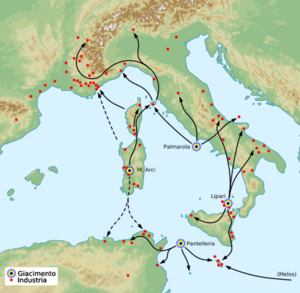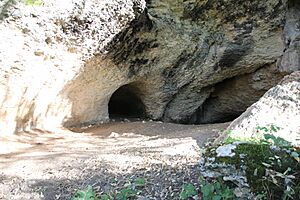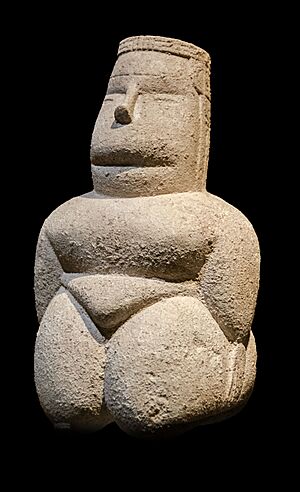Pre-Nuragic Sardinia facts for kids
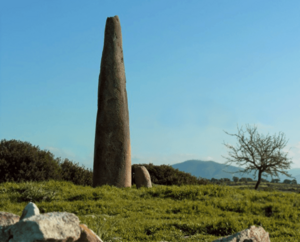
The Pre-Nuragic period is about the very old history of Sardinia. It covers the time from the Paleolithic (Old Stone Age) up to the middle Bronze Age. This was before the famous Nuragic civilization became big on the island.
People didn't know how to write back then. So, we learn about their lives from what archaeologists find. These are things like old tools, pottery, and other objects. They tell us about the "material culture" – the things people made and used.
Contents
The Old Stone Age (Paleolithic)
Scientists have found old stone tool workshops in Sardinia. These show that people lived on the island between 450,000 and 10,000 years ago.
Researchers believe an early human, nicknamed "Nur," first came to Sardinia about 250,000 years ago. This was during the Lower Paleolithic period. They found a finger bone in the Nùrighe caves of Cheremule. Some think "Nur" might have been a pre-Neanderthal human.
During the last ice age, sea levels were much lower. Sardinia and Corsica were one big island then. They were separated from Tuscany by only a narrow stretch of sea.
The oldest remains of Homo sapiens (modern humans) in Sardinia are from the Upper Paleolithic. Their traces were found in the "Corbeddu cave" in Oliena, central Sardinia.
The Middle Stone Age (Mesolithic)
Human remains from the Mesolithic period were found at the "Su Coloru cave" in Laerru. This is in northern Sardinia. The tools and items found suggest these people came to Sardinia from the Italian peninsula. They likely used simple boats to cross the sea.
The oldest complete human skeleton found in Sardinia was named "Amsicora." It was discovered in 2011 near Arbus. This skeleton is about 9,000 years old. It dates to the time when the Mesolithic was changing into the Neolithic period.
The New Stone Age (Neolithic)
Su Carroppu Culture
The Su Carroppu culture marks the very start of the Neolithic in Sardinia. This was around 6,000 BC. In 1968, archaeologists found rough, dark-grey pottery in a rock shelter called "Su Carroppu." This pottery was decorated with shell prints. They also found tools made from obsidian from Monte Arci.
They discovered animal bones from deer, wild boar, and a rabbit-like animal called Prolagus sardus. This shows that people farmed, hunted, and fished. Two human skeletons were also found with shell ornaments. This suggests how they buried their dead.
The Su Carroppu culture is similar to cultures in Corsica, Italy, and Spain. Finds in Sardinia and Corsica help us understand how farming and new ways of life spread across the northwest Mediterranean Sea.
Grotta Verde Culture
The Grotta Verde culture is named after a cave near Alghero. Important discoveries were made there in 1979. This culture existed in the mid-fifth millennium BC.
It was found in northwest Sardinia. People from this culture made fine pottery. They decorated it using a special toothed tool.
One vase found in the cave had handles shaped like human heads. These had small noses, eyes, and mouths. According to archaeologist Giovanni Lilliu, this might be the first human-like art in Sardinian prehistory. Unusual drawings were also found on a cave wall.
Filiestru Culture
In 1971, a priest and cave explorer named Renato Loria found a cave near Mara. Later, archaeologists VR Switsur and David H. Trump explored it. They found signs of many different cultures over a long time.
The oldest culture found there dates to the late fifth millennium BC. These people farmed, raised animals, hunted, and fished. They used less pottery decoration than before. They also made large greenstone rings, like those found in Corsica and Italy. This suggests Sardinians traded a lot with other groups around the Mediterranean.
Bonu Ighinu Culture
The Bonu Ighinu culture lasted from 4000 BC to 3400 BC. It's named after a sanctuary near the "cave of de Tintirriolu" in Mara. Many pottery pieces with animal and human-like handles were found there. This culture spread across most of Sardinia. A key village was "Puisteris" in Mogoro.
Archaeologists believe this was the first culture in Sardinia to use artificial caves as graves. It grew out of the earlier Filiestru culture, found in the same area.
Discoveries at "Cuccuru S'Arrius" show a well-organized society. Many female statues, called "Mother Goddess" figures, were found here. The worship of a Mother Goddess was common in Europe and the Mediterranean during the Neolithic. These figures were shown standing, sitting, or breastfeeding.
San Ciriaco Culture
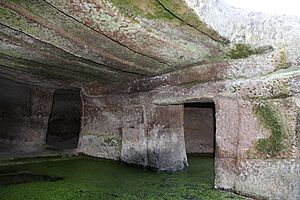
The San Ciriaco culture (3400-3200 BC) marks the end of the Middle Neolithic. It is seen as a link between the Bonuighinu and Ozieri cultures.
It is named after the Church of St Cyriacus in Terralba. A prehistoric village with many artifacts was found nearby.
During this time, the first "Domus de Janas" were built. These are special underground tombs. They became common across the island, except in the Gallura region.
Arzachena Culture
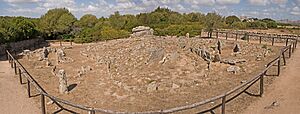
The Arzachena culture was mostly found in the Gallura region and parts of eastern Sardinia. It also reached southern Corsica. So, it's sometimes called the "Corsican-Gallurese cultural aspect."
The large "circular graves" of Gallura show the start of megalithism (building with large stones) in Sardinia. This is one of the oldest examples in the western Mediterranean. Items found in these graves included fine cups, flint knives, small stone axes, and necklaces.
Ozieri Culture
The Ozieri culture (3200-2700 BC) is also known as the "culture of St. Michael." It's named after a cave in Ozieri where important finds were made. Beautifully made vases were found there. They were decorated with geometric patterns carved into the clay and painted with red color. The older vases were round, while later ones were more stylish.
Experts believe this type of pottery was new to Sardinia. Similar items were found in the Cyclades islands and Crete. This shows that Sardinians traded a lot with these distant islands. New ways of making things, working with metals, and living appeared in Sardinia. These finds prove strong cultural and trade links between early Sardinians and Neolithic Greece.
Because of these important discoveries, many scholars call the Ozieri culture the first great culture of Sardinia.
The Copper Age (Chalcolithic)
Sub-Ozieri Culture
The Sub-Ozieri culture (also called "Red Ozieri") existed between 2850 and 2700 BC. It was a continuation of the earlier Ozieri culture, especially in central and southern Sardinia.
Obsidian was used less often. Instead, people started working with copper and silver.
Abealzu-Filigosa Culture
This culture is named after two places: Abealzu in Osilo and Filigosa in Macomer. It developed between 2700 and 2400 BC. It was mostly found in about a dozen sites near Sassari and a few in south-central Sardinia.
These people honored their ancestors by setting up statue menhirs (tall stone statues). They also built or fixed the large stone temple of Monte d'Accoddi near Sassari. This temple was probably used to worship the Sun god.
Items found in graves included copper daggers, stone axes, and obsidian arrowheads. Abealzu pottery looks similar to pottery from the Rinaldone culture in Italy.
Monte Claro Culture
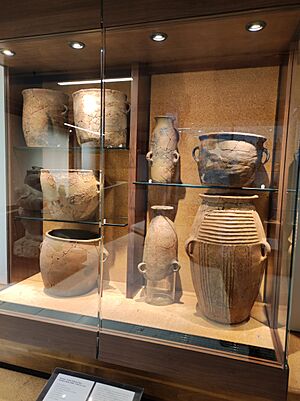
The Monte Claro culture spread across Sardinia between 2400 and 2100 BC. New things included "oven-shaped" tombs, which were individual graves found near Cagliari. They also built large stone walls in central-northern Sardinia, like the one at "Monte Baranta" near Olmedo.
The pottery from this culture shows influences from the east in the south of the island. In the north, it shows influences from the Fontbouisse culture in southern France.
Beaker Culture
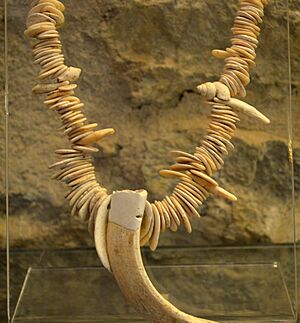
The Beaker culture came from outside Sardinia. Its people mixed with the local groups already living there. It was mainly found along the west coast and nearby lowlands. There are fewer finds on the east coast.
These people made fine pottery. They also used stone wrist-guards, copper daggers, bracelets, rings, and necklaces made of shells or animal tusks. For the first time, gold items appeared on the island, like those found in the Tomb of Bingia 'e Monti in Gonnostramatza.
The Beaker culture in Sardinia had three main phases:
- The oldest phase (2100–2000 BC) had strong influences from Spain and southern France.
- A second phase (2000–1900 BC) showed clear influences from Central Europe.
- A third phase (1900–1800 BC) is seen at sites like "Lu Marinaru" and "Padru Jossu."
Early Bronze Age
Bonnanaro Culture

Around 1800 BC, the Bonnanaro culture spread across Sardinia. This culture was a local version of the earlier Beaker culture. It also had influences from the Polada culture in northern Italy.
People of this culture probably built the first "protonuraghi" or "pseudonuraghi." These were early versions of the famous Nuraghe towers. They had a base with a corridor and stairs leading to a terrace.
Ancient DNA (Genetics)
Recent studies of ancient DNA (from 2020) show that early Sardinians from the Neolithic period were very similar to people from Spain and southern France. In the Copper Age that followed, their genes stayed mostly the same. The amount of genes from early European farmers and hunter-gatherers remained steady. Unlike central and northern Europe, there was no major gene flow from the Pontic-Caspian steppe into Sardinia during the Beaker culture period.
However, a 2022 study suggested a small amount of gene flow from the Western Steppe Herders around 2600 BC.
Early Sardinians from the Pre-Nuragic period mostly had brown eyes, dark brown or black hair, and a medium or mixed skin tone.
See also
- Paleolithic Europe
- Neolithic Europe
- Chalcolithic Europe
Literature
- Atzeni E., La preistoria del Sulcis-Iglesiente, AA.VV., Iglesias. Storia e Società, Iglesias, 1987
- AA.VV., Carbonia e il Sulcis. Archeologia e territorio, a cura di V. Santoni, Oristano, 1995.
- AA.VV., Ichnussa. La Sardegna dalle origini all'età classica, Milano, 1981.
- AA.VV. La civiltà in Sardegna nei secoli - Torino - Edizioni ERI.
- Barreca F., L'esplorazione topografica della regione sulcitana, Monte Sirai III, 1966
- AA.VV., La Sardegna preistorica. Storia, materiali, monumenti, 2017
- Brigaglia M., Mastino A., Ortu G. Storia della Sardegna 1. Dalle origini al Settecento, Bari, 2006.
- Casula F.C., La storia di Sardegna - Sassari 1994.
- Contu E., Monte d'Accoddi (Sassari). Problematiche di studio e di ricerca di un singolare monumento preistorico Deja Conference, BAR. s. 288. Oxford. (1984)
- Lilliu G., La civiltà dei Sardi dal neolitico all'età dei nuraghi. Torino - Edizioni ERI - 1967.
- Lilliu G., Sculture della Sardegna nuragica Verona 1962.
- Lo Schiavo F., L. Usai, Testimonianze cultuali di età nuragica: la grotta Pirosu in località Su Benatzu di Santadi
- Sirigu R., Archeologia preistorica e protostorica della Sardegna. Introduzione allo studio, Cagliari, CUEC, 2009.
- Tine S., Monte d'Accoddi 10 anni di nuovi scavi. - Sassari - 1992.
- G. Webster and M. Webster (2017). Punctuated Insularity. The Archaeology of 4th and 3rd millennium Sardinia, Oxford: BAR International Series 2871
- Gary Webster (2019). The Sardinian Neolithic: An Archaeology of the 6th and 5th Millennia BCE. BAR int. Ser. 2941. Oxford: BAR Publishing.


